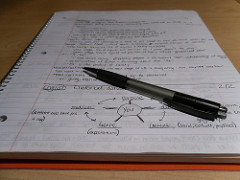4.2: Lesson 4.2: Note-Taking Part 2, Key Information and Formats
- Page ID
- 20604

“Notes” by English106 is licensed under CC BY 2.0
Perhaps the most useful learning tools of all are notes taken from both lectures and course materials. By annotating for key information, then condensing it, students not only create personalized summaries but also aid their memory by using both visual and kinesthetic learning styles. Add auditory, too, if the notes are taken from a lecture or video.
Often, students are unsure about what constitutes “key information.” Here is a list of items to highlight or annotate for in textbooks and a list of items to listen for in lectures.
Key Information in Textbooks
In addition to paying attention to all the items listed in Lesson 3.2, Getting the Most Out of Your Textbooks, the following elements of a textbook chapter are especially important in helping you discern key information:
- Introductions
- Summaries
- Study questions
- Topic sentences (as the speaker in the video on “Skim Reading,” exercise 3.2, also in Lesson 3.2 notes: sometimes the reader has to read the first two or even three sentences of a paragraph or section to get the entire main topic).
- Anything that is bolded, or in some other way set off from the default print size and style. Sub-topic titles are good examples of this.
- “Side bars,” which are boxes of related information. These might include statistics, brief biographies of authors or persons of note related to the chapter content, price points on brochures for businesses, charts, graphs, photographs, and/or illustrations. They are typically a different color or in some other way set off for attention but not as the focal point of the text. Pay attention to the captions or legends that might accompany graphics. In this e-text, the exercises are set apart in side bars.
- Glossary terms that may be incorporated in the margins or otherwise set apart.
- Some textbooks include outlines of each chapter’s main points in the introductory section.
Key Information in Lectures
As the lecturer, live or video, presents the material, there are two types of key information cues to be aware of.
NONVERBAL CUES
As covered in the previous lesson on listening skills, a speaker will often have unique facial and body nonverbal cues that alert you to several things, as you learn to “read” your professor:
- Stances or movements that alert you to when he/she will shift to a different topic or subtopic.
- Other cues that alert you to when the information is of special significance (including verbal clues, below).
VERBAL CLUES
- Pay attention to when the speaker uses any of the transition clues used in reading comprehension, as listed in Lesson 3.3, context clues. Click on common clue words for a separate list.
- Many speakers also announce when they are adding information or changing topics in various other ways.
For tips on how to deal with fast talkers, when you should NOT take notes, what note-taking formats work well, and other advice, complete the exercise below.
UNIT 4, EXERCISE 2.1
- Download and read Study Tip #9-Taking Useful Class Notes, by Dan Hodges, found on the PDF file with all of his articles. Scroll down to #9.
- Number each of the 7 sections for easy reference.
- As you read, annotate (highlight, circle, underline, write marginal notes, etc.) for items that you especially want to remember from each of the 7 topics.
- Transfer the notes to a Cornell Note-Taking form. Hodges also includes instructions for creating your own form. Hodges features the Cornell format in section 4, “What Style of Note-Taking Works Well?”
Example:
KEY POINTS DETAILS
section 1: Why take notes? Good notes=better grades
(add the rest of the details)
UNIT 4, EXERCISE 2.2
There are, of course, as many ways to take notes as there are note-takers with creative minds! For this exercise, do an online search using the key words, “fun and creative ways to take notes YouTube.” Preview as many as you like. Pick one (these are all fairly short), then take notes on it (!) in the creative way suggested. Be sure to cite the YouTube source (title and URL) in your notes.

